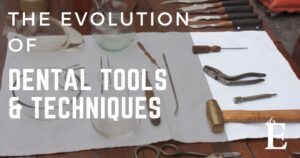The Evolution of Dental Tools and Techniques: A Historical Perspective
Dentistry, as a field, has undergone an incredible transformation over the centuries. From ancient remedies and rudimentary tools to sophisticated, technology-driven practices, the journey of dental care reflects humanity’s unceasing quest for better health and well-being. Let’s take a fascinating look at the evolution of dental tools and techniques, tracing their development from ancient times to the modern day.
Ancient Dental Practices
The history of dentistry can be traced back thousands of years. Evidence of dental work dates as far back as 7000 BC in the Indus Valley Civilization, where archaeologists have discovered skulls with drilled teeth. These early dental procedures were performed using bow drills, a tool originally designed for woodworking. Remarkably, these ancient dentists had an impressive understanding of tooth structure and were surprisingly precise.
In ancient Egypt, dental health was considered important, and early dentists practiced a range of techniques. They used a mixture of barley and honey to create a type of dental cement and even fashioned rudimentary dental bridges using gold wire to hold replacement teeth in place. The famous Egyptian medical text, the Ebers Papyrus, includes references to toothaches and treatments, showcasing an early understanding of oral health.
The Middle Ages: From Barbers to Surgeons
During the Middle Ages, dental care was primarily in the hands of barbers and general physicians. Barbers, who were also surgeons at the time, performed tooth extractions and other minor dental procedures. This period saw little advancement in dental tools or techniques, and most dental care was focused on alleviating pain rather than preventive measures.
The Renaissance: Birth of Modern Dentistry
The Renaissance era marked a significant turning point in dental history. In 1530, the first book dedicated entirely to dentistry, “Artzney Buchlein,” was published in Germany. This book provided detailed instructions on oral hygiene, tooth extraction, and the placement of gold fillings.
French surgeon Pierre Fauchard, often referred to as the “Father of Modern Dentistry,” made groundbreaking contributions in the 18th century. His seminal work, “Le Chirurgien Dentiste,” published in 1728, laid the foundation for modern dental practices. Fauchard introduced dental fillings, dental prosthetics, and the use of dental braces to correct tooth alignment. He also developed tools that resemble modern dental instruments, such as the dental drill.
The 19th Century: The Dawn of Dental Science
The 19th century saw the establishment of dentistry as a recognized profession. The introduction of anesthesia in the 1840s revolutionized dental procedures, making them more comfortable for patients. Nitrous oxide (laughing gas) and ether were the first anesthetics used in dental surgeries, significantly reducing pain and anxiety.
In 1895, German physicist Wilhelm Conrad Roentgen discovered X-rays, a breakthrough that allowed dentists to see inside the mouth and diagnose issues with unprecedented accuracy. This advancement marked the beginning of diagnostic radiology in dentistry.
The 20th Century: Technological Advancements
The 20th century brought rapid advancements in dental technology and techniques. The development of high-speed drills in the 1950s made dental procedures faster and more efficient. Fluoride toothpaste and water fluoridation programs were introduced, significantly improving dental health and reducing the prevalence of cavities.
Dental materials also evolved, with the introduction of composite resins and dental implants. Composite resins provided a more aesthetically pleasing alternative to traditional metal fillings, while dental implants offered a permanent solution for missing teeth, greatly enhancing patients’ quality of life.
The 21st Century: Digital Dentistry and Beyond
Today, dentistry is at the forefront of technological innovation. Digital dentistry, which includes technologies like CAD/CAM (computer-aided design and computer-aided manufacturing), has revolutionized the design and production of dental restorations. 3D printing is now used to create precise dental models, crowns, and bridges, making treatments more efficient and accurate.
Laser dentistry is another significant advancement, offering minimally invasive options for procedures like cavity removal, gum reshaping, and teeth whitening. This technology reduces discomfort and speeds up recovery times.
Teledentistry has also emerged as a valuable tool, especially during the COVID-19 pandemic, allowing dentists to provide consultations and follow-up care remotely. This has increased accessibility to dental care for many patients.
Looking Ahead
The future of dentistry promises even more exciting developments. Researchers are exploring regenerative dentistry, which aims to use stem cells to grow new teeth and repair damaged tissues. Artificial intelligence (AI) is being integrated into diagnostic tools, helping dentists identify issues with greater accuracy and efficiency.
As we look back on the history of dental tools and techniques, it’s clear that the field has made remarkable strides. From ancient bow drills to digital scanners, each innovation has brought us closer to achieving optimal oral health. At Dr. E’s Cosmetic & Family Dentistry, we are proud to be part of this incredible journey, continually adopting the latest technologies to provide our patients with the best possible care.
Stay tuned as we continue to embrace the future of dentistry, ensuring that your smile remains healthy and bright for years to come. Call us at 480-494-2435 for a free second opinion or smile make-over consultation.


